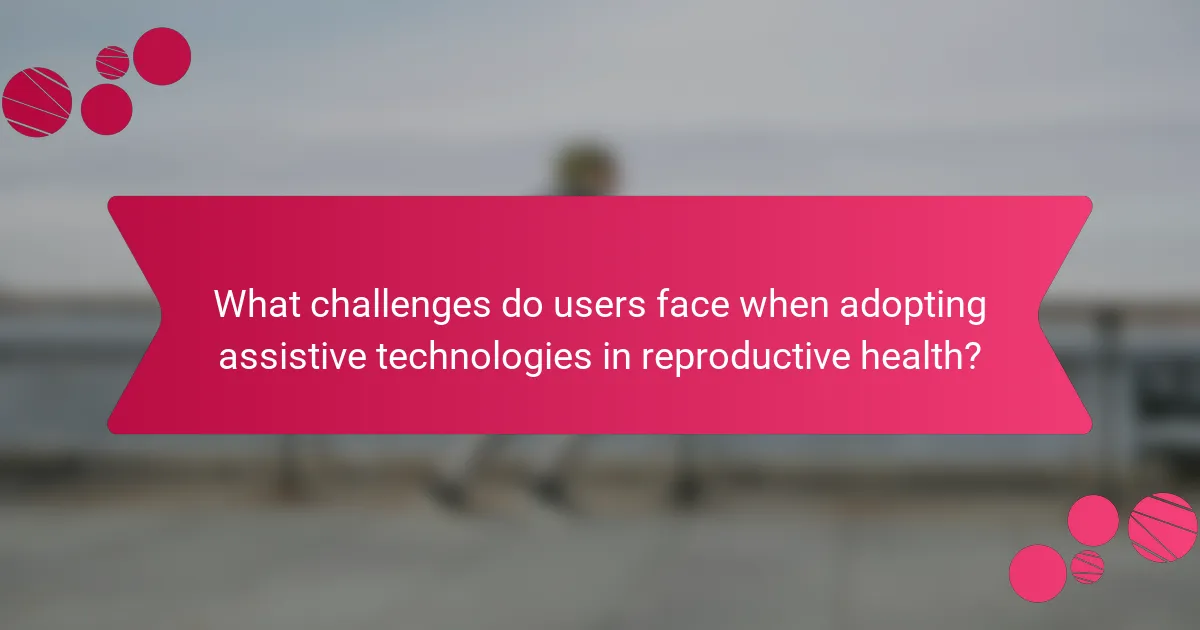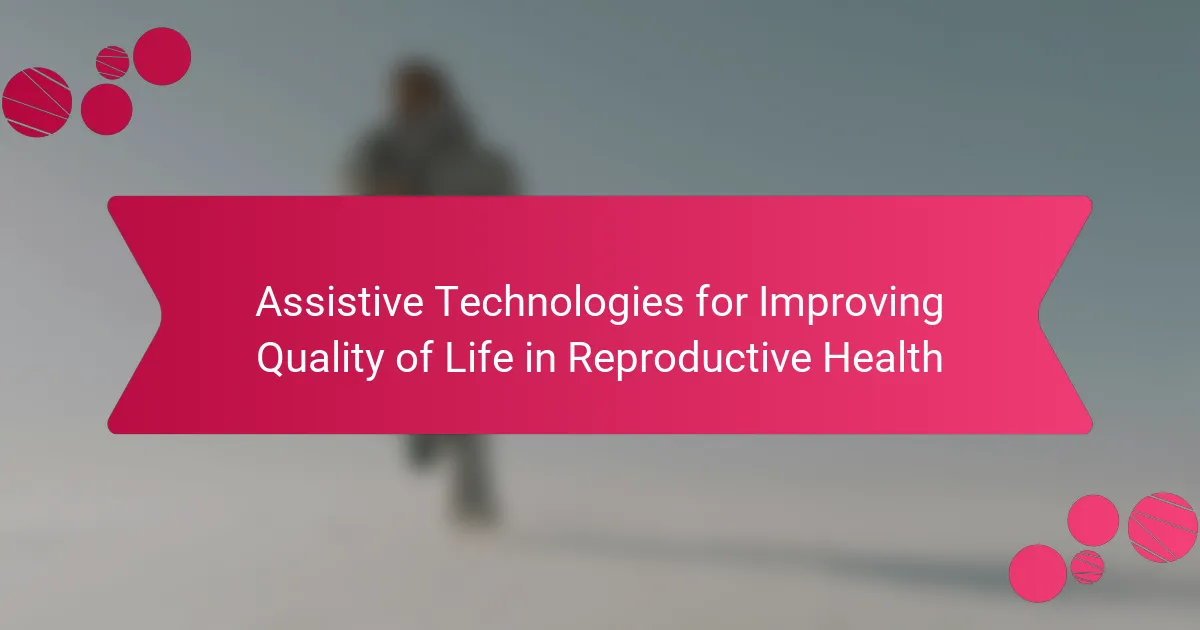Assistive technologies play a crucial role in enhancing reproductive health by improving accessibility, monitoring, and education. Innovations such as mobile health applications and wearable devices empower individuals to manage their reproductive health effectively. However, challenges like cost, privacy concerns, and cultural perceptions can hinder adoption. Understanding these factors is essential for fostering greater acceptance and utilization of these technologies.

How do assistive technologies enhance reproductive health outcomes?
Assistive technologies enhance reproductive health outcomes by providing tools that improve accessibility, monitoring, and education. These technologies enable individuals to manage their reproductive health more effectively. For instance, wearable devices track fertility cycles and hormonal changes, offering personalized insights. Mobile applications facilitate access to educational resources, empowering users with knowledge about reproductive health. Telehealth services expand access to specialists, ensuring timely interventions. Overall, these innovations contribute to better informed decisions and improved health management.
What are the key benefits of using assistive technologies in reproductive health?
Assistive technologies enhance reproductive health by improving accessibility, providing support for fertility treatments, and facilitating communication with healthcare providers. These technologies empower individuals to manage their reproductive health more effectively and confidently.
Key benefits include:
1. Increased access to reproductive health resources.
2. Enhanced monitoring of reproductive health conditions.
3. Improved communication with healthcare professionals.
4. Support for mental health during fertility treatments.
5. Greater autonomy in managing reproductive choices.
Which assistive technologies are most commonly used in reproductive health?
Assistive technologies commonly used in reproductive health include fertility tracking apps, telehealth platforms, wearable health monitors, and assisted reproductive technology (ART) devices. These tools enhance patient engagement, improve monitoring, and support informed decision-making. Fertility tracking apps offer personalized insights into menstrual cycles, while telehealth platforms provide remote consultations with specialists. Wearable health monitors track physiological data, and ART devices facilitate procedures such as in vitro fertilization.
How do these technologies improve patient engagement and education?
Assistive technologies enhance patient engagement and education by providing personalized information and support. These tools facilitate communication between patients and healthcare providers, improving understanding of reproductive health issues. For instance, mobile apps offer tailored resources, reminders, and educational content, empowering patients to take charge of their health. As a result, patients experience increased satisfaction and adherence to treatment plans.

What challenges do users face when adopting assistive technologies in reproductive health?
Users face several challenges when adopting assistive technologies in reproductive health, including cost, accessibility, and lack of awareness. Many technologies are expensive, limiting access for some individuals. Additionally, users may struggle to find reliable information about available options. Training and support are often insufficient, leading to difficulties in effective usage. Privacy concerns also hinder adoption, as users may fear sharing sensitive health data.
Which barriers limit access to assistive technologies for reproductive health?
Barriers limiting access to assistive technologies for reproductive health include high costs, lack of awareness, and inadequate training. Many individuals face financial constraints that prevent them from obtaining necessary devices. Additionally, healthcare providers may not fully understand the available technologies, leading to underutilization. Geographic disparities further complicate access, as rural areas often lack resources.
How can healthcare providers support users in overcoming these challenges?
Healthcare providers can support users by offering tailored guidance and access to assistive technologies. They should conduct assessments to identify specific challenges and recommend appropriate solutions. Training users on effective technology use enhances confidence and improves outcomes. Collaboration with multidisciplinary teams ensures comprehensive care and support. Regular follow-ups can help address ongoing issues and adapt strategies as needed.

What role do cultural perceptions play in the acceptance of assistive technologies?
Cultural perceptions significantly influence the acceptance of assistive technologies in reproductive health. Societal attitudes can either encourage or hinder the integration of these technologies into daily life.
For instance, cultures that prioritize traditional practices may resist adopting new technologies, viewing them as unnecessary or intrusive. In contrast, societies that value innovation tend to embrace assistive devices, recognizing their potential to enhance quality of life.
Moreover, awareness and education about the benefits of assistive technologies play a crucial role. Communities that understand how these tools can improve reproductive health outcomes are more likely to support their use.
Ultimately, fostering positive cultural perceptions through education and advocacy can enhance acceptance and utilization of assistive technologies in reproductive health.
How do different regions perceive the use of technology in reproductive health?
Different regions have varied perceptions of technology in reproductive health, influenced by cultural, economic, and educational factors. In some areas, technology is embraced for enhancing access to care, while in others, traditional practices prevail.
For instance, in developed nations, telemedicine and reproductive health apps are widely accepted, improving patient engagement and monitoring. Conversely, in developing regions, limited internet access and digital literacy hinder the adoption of such technologies.
Moreover, the perception of assistive technologies varies significantly. In progressive societies, these tools are seen as essential for empowering individuals, while in conservative cultures, they may face skepticism or resistance due to cultural norms.
The integration of technology in reproductive health continues to evolve, reflecting the unique needs and values of different populations.
What are the implications of cultural beliefs on technology adoption?
Cultural beliefs significantly influence technology adoption, including assistive technologies in reproductive health. These beliefs shape perceptions about health, gender roles, and the acceptance of new interventions. For example, communities with strong traditional views may resist modern technologies, preferring established practices. As a result, understanding cultural contexts is essential for successful implementation and user acceptance of assistive technologies. Engaging with community leaders and tailoring educational efforts can enhance adoption rates and improve reproductive health outcomes.

Which innovative assistive technologies are emerging in reproductive health?
Innovative assistive technologies are emerging to enhance reproductive health through improved accessibility and personalized care. These technologies include mobile health applications, telemedicine platforms, wearable devices for monitoring reproductive health, and AI-driven tools for fertility tracking.
Mobile health applications offer users resources for menstrual tracking, fertility awareness, and reproductive health education. Telemedicine platforms provide remote consultations, increasing access to healthcare professionals. Wearable devices, such as smartwatches, can monitor physiological data, helping individuals understand their reproductive cycles better. AI-driven tools analyze patterns in data to predict fertility windows and provide personalized recommendations.
These advancements aim to empower individuals in managing their reproductive health effectively, fostering greater autonomy and informed decision-making.
What unique features differentiate these new technologies from traditional methods?
Assistive technologies enhance reproductive health by offering personalized, data-driven solutions unlike traditional methods. These technologies leverage real-time monitoring, user-friendly interfaces, and integration with digital health platforms. For instance, wearable devices provide continuous health tracking, enabling timely interventions. Additionally, telehealth services improve access to care, allowing consultations from home. Such innovations empower users with actionable insights, fostering proactive health management.
How are advancements in technology shaping future reproductive health solutions?
Advancements in technology are significantly enhancing reproductive health solutions. Innovations like telemedicine, wearable health trackers, and AI-driven diagnostics improve access and personalized care.
Telemedicine expands patient reach, allowing consultations without geographical barriers. Wearable health devices monitor reproductive health metrics, providing real-time data for better decision-making. AI tools analyze large datasets to predict fertility patterns, offering tailored solutions.
These technologies also address unique challenges, such as infertility and menstrual disorders, by providing targeted interventions. For instance, apps that track ovulation cycles empower individuals with knowledge about their reproductive health.
As a result, the future of reproductive health is increasingly data-driven and patient-centered, promising improved outcomes and quality of life.

How can data privacy and security be ensured in assistive reproductive technologies?
Data privacy and security in assistive reproductive technologies can be ensured through robust encryption, strict access controls, and compliance with regulations. Implementing end-to-end encryption protects sensitive data during transmission. Access controls restrict data to authorized personnel, minimizing exposure. Compliance with regulations like GDPR ensures that patient data is handled responsibly. Regular audits and risk assessments further enhance security measures.
What are the main privacy concerns users have about these technologies?
Users are primarily concerned about data security, unauthorized access, and privacy breaches when using assistive technologies in reproductive health. These technologies often collect sensitive personal information, raising fears about how data is stored and shared. Users worry that their health data could be exploited or mishandled, leading to potential discrimination or loss of confidentiality. Additionally, the lack of transparency regarding data usage policies can exacerbate these concerns, making users hesitant to fully engage with such technologies.
How can developers address security issues to build user trust?
Developers can build user trust by prioritizing security measures in assistive technologies for reproductive health. Implementing robust encryption protocols safeguards user data. Regular security audits identify vulnerabilities, enhancing system integrity. Transparency in data handling practices fosters trust. User education on security features empowers informed decisions.

What are the best practices for integrating assistive technologies into reproductive health care?
Integrating assistive technologies into reproductive health care enhances accessibility and improves patient outcomes. Key best practices include ensuring user-friendly interfaces, providing comprehensive training for healthcare providers, and incorporating feedback from users with disabilities to refine technologies. Additionally, maintaining compliance with accessibility standards is crucial for effective integration. Regular assessments of technology effectiveness can lead to continuous improvement in reproductive health services.
How can healthcare professionals effectively implement these technologies?
Healthcare professionals can effectively implement assistive technologies by prioritizing user-centered design, ensuring accessibility, and providing comprehensive training. Engaging with patients during the selection process enhances satisfaction and usability. Regularly evaluating technology effectiveness promotes continuous improvement in reproductive health outcomes. Collaboration with multidisciplinary teams can further optimize the integration of these technologies into practice.
What common mistakes should be avoided during technology integration?
Common mistakes during technology integration in reproductive health include insufficient training, neglecting user feedback, underestimating costs, and failing to ensure compatibility. These pitfalls can hinder the effectiveness of assistive technologies designed to enhance quality of life. Prioritizing thorough training and ongoing support can mitigate these issues. Engaging users in the integration process ensures the technology meets their needs. Additionally, conducting a comprehensive cost analysis helps in budget planning and resource allocation. Ensuring compatibility with existing systems is crucial for seamless integration and functionality.
Which strategies can enhance user experience with assistive technologies in reproductive health?
Implementing user-centered design enhances user experience with assistive technologies in reproductive health. Strategies include personalized interfaces, voice recognition, and mobile accessibility.
Personalized interfaces allow users to customize settings, improving usability. Voice recognition enables hands-free operation, making technology more accessible. Mobile accessibility ensures users can access assistive tools anytime, anywhere, fostering independence.
Regular user feedback is crucial for continuous improvement. Engaging users in the design process leads to technologies that better meet their needs. Training and support resources further enhance user confidence and competence with assistive technologies.
